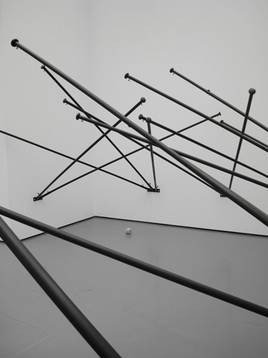Latifa Echakhch
dal 15/11/2012 al 23/2/2013
Segnalato da
15/11/2012
Latifa Echakhch
Kunsthaus Zurich, Zurich
Goodbye horses. Her works deal with political and cultural structures and systems. Adopting an approach that is both poetic and conceptual, she reflects on our often-prejudiced perception of the unfamiliar, of national and religious identities. She is creating new works in which the leitmotif is the circus.

From 16 November 2012 to 24 February 2013, the Kunsthaus Zürich presents
‘Goodbye Horses,’ an exhibition by the French-Moroccan artist Latifa
Echakhch. Echakhch’s works explore issues of cultural transfer and the shifts
of identity that they entail. She is creating new works for the Kunsthaus that
will be shown exclusively in Zurich. Their leitmotif is the circus.
When Latifa Echakhch (born 1974) made her first museum appearance in the
group exhibition ‘Shifting Identities’ (2008), her name was still unknown.
Nevertheless, the work she displayed – a group of bare flagpoles painted black
and criss-crossing in space entitled ‘Fantasia’ – attracted considerable
attention. Since then Echakhch, who was born in Morocco and now lives in
Martigny, Switzerland, has been a participant in the 2011 Venice Biennale and
the 2012 Biennale of Sydney. Renowned institutions such as Tate Modern,
London, have given her solo exhibitions. Now, the artist has returned from her
global travels to her very first museum venue, the Kunsthaus Zürich. The
presentation ‘Goodbye Horses,’ prepared by Echakhch together with curator
Mirjam Varadinis, consists of new works created specially for the collection
galleries that will be shown exclusively at the Kunsthaus.
LEITMOTIF OF THE CURRENT SHOW: THE CIRCUS AND EMPTINESS
The central motif of these new works is the circus. Echakhch is interested not in
its jolly, cheerful side but rather the melancholy aspect of spectacle and
emptiness. There is a pervasive sense of abandonment; the works appear to be
left over from a long finished exhibition. As the artist herself explains, ‘the circus
actually represents the idea of the spectacle that lives entirely from the tension
of the moment. But the theme of the exhibition is precisely the end of this “here
and now.”’
The idea of something that exists only through its absence is one that has
preoccupied Echakhch for some time. Yet for her, the idea of emptiness goes
still further. Only when supposedly known objects have been emptied of their
original meaning can they be read in new ways – and this is exactly what
Echakhch does. She uses objects that we all know well, such as the typical
architectural elements and props of the circus – the ring, costumes, pedestal
and circus tent. She has arranged such a tent in the collection galleries of the
Kunsthaus so that visitors feel as if they were walking across the roof of the
circus – a poetic change of perspective. Yet the political component for which
Echakhch is known is still present. Her installation at the Kunsthaus pinpoints
the inner emptiness of our ‘event’ society and the fact that today ‘everything
happens so fast that it is over even before it has begun.’ At the same time, she
also references the history of the circus and the ‘freak shows’ in which people
with abnormalities of all kinds were put on display. These shows, of which P.T.
Barnum’s circus was a famous example, lived from staging the act of gazing on
the unfamiliar – a theme of central importance for Echakhch, as may already be
seen in her early work.
LEVEL OF POLITICAL MEANING
Echakhch has, since the beginning of her career, reflected on the often
prejudiced perception of national and religious identities in works that are both
poetic and conceptual. Titles play an important role, as in the installation
‘Stoning’ (2010). Stones lying on the ground seem at first glance to be
innocuous. The term ‘stoning,’ however, immediately evokes images of brutal
executions and charges the work with a new level of meaning. When viewed
from a distance, ‘À chaque stencil une révolution’ (2007) is reminiscent of an
abstract mural. Yet the title triggers quite different associations, recalling a time
when political manifestos were reproduced using the blue carbon paper that
Echakhch here deploys in her work. Each of the sheets glued to the wall stands
for the possibility of a revolution; and so the seemingly abstract painting is
transformed into a politically explosive wall hanging.
Supported by the Stanley Thomas Johnson Foundation and the Erna and Curt
Burgauer Foundation.
Image: Fantasia (Empty Flag, Black), 2008; Globus, 2007
View of the exhibition ‘Shifting Identities’, Kunsthaus Zürich, 2008
Courtesy of the artist und Kamel Mennour, Paris
© Latifa Echakhch
For further press information please contact: Kunsthaus Zürich, Kristin Steiner
kristin.steiner@kunsthaus.ch, tel. +41 (0)44 25384133I3
Kunsthaus Zürich
Heimplatz 1, CH-8001 Zurich
Opening hours: Sat, Sun, Tues 10 a.m.–6 p.m., Wed, Thur, Fri 10 a.m.–8 p.m.
Public holidays: 26 December, 1/2 January 2013: 10 a.m. – 6 p.m. Closed 24 / 25/ 31 December.
Admission: CHF 15 / CHF 10 (concessions) including collection. Children and young people up to the age of 16 free of charge. Combined ticket including the
exhibitions ‘The New Kunsthaus’ and ‘Paul Gauguin’ CHF 25 / CHF 18
(concessions) / CHF 20 for groups of 20 or more.
Public guided tours: Sunday 18 November, 12 midday and Saturday 8 December,
11 a.m. Places limited.



